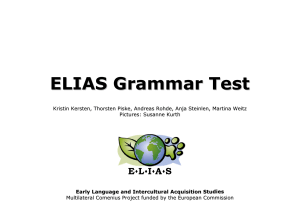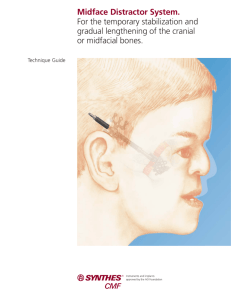basics.fmri.firstlevel
advertisement
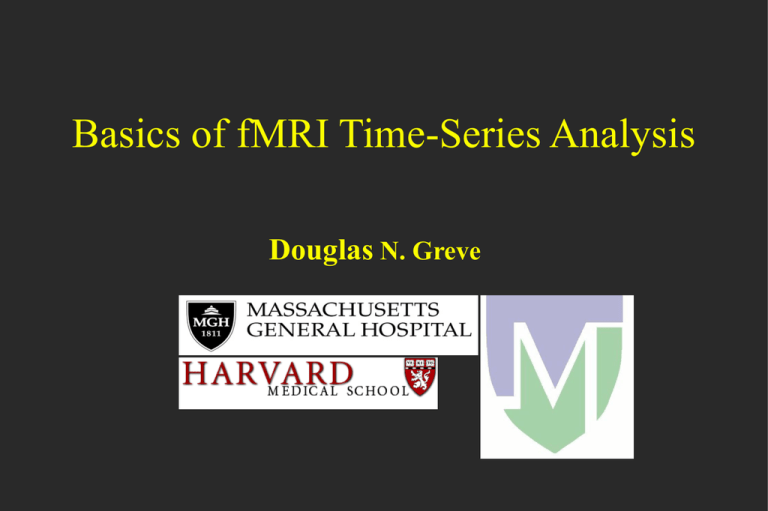
Basics of fMRI Time-Series Analysis Douglas N. Greve fMRI Analysis Overview Subject 1 Raw Data Preprocessing MC, STC, B0 Smoothing Normalization First Level GLM Analysis X Subject 2 Raw Data Preprocessing MC, STC, B0 Smoothing Normalization C First Level GLM Analysis X C Higher Level GLM Subject 3 Raw Data Preprocessing MC, STC, B0 Smoothing Normalization First Level GLM Analysis X X C C Subject 4 Preprocessing MC, STC, B0 Smoothing Normalization Raw Data First Level GLM Analysis X C 2 Overview • • • • • Neuroanatomy 101 fMRI Contrast Mechanism Hemodynamic Response “Univariate” GLM Analysis Hypothesis Testing 3 Neuroantomy • Gray matter • White matter • Cerebrospinal Fluid 4 Functional Anatomy/Brain Mapping 5 Visual Activation Paradigm Flickering Checkerboard Visual, Auditory, Motor, Tactile, Pain, Perceptual, Recognition, Memory, Emotion, Reward/Punishment, Olfactory, Taste, Gastral, Gambling, Economic, Acupuncture, Meditation, The Pepsi Challenge, … • Scientific • Clinical • Pharmaceutical 6 MRI Scanner 7 Magnetic Resonance Imaging T1-weighted Contrast BOLD-weighted Contrast 8 Blood Oxygen Level Dependence (BOLD) Oxygenated Hemoglobin (DiaMagnetic) Neurons Deoxygenated Hemoglobin (ParaMagnetic) Lungs Contrast Agent Oxygen CO2 9 Functional MRI (fMRI) Stimulus Localized Neural Firing Localized Increased Blood Flow Localized BOLD Changes Sample BOLD response in 4D Space (3D) – voxels (64x64x35, 3x3x5mm^3, ~50,000) Time (1D) – time points (100, 2 sec) – Movie Time 1 Time 2 Time 3 … 10 4D Volume 64x64x35 85x1 11 Visual/Auditory/Motor Activation Paradigm 15 sec ‘ON’, 15 sec ‘OFF’ • Flickering Checkerboard • Auditory Tone • Finger Tapping 12 Block Design: 15s Off, 15s On Voxel 1 Voxel 2 13 Contrasts and Inference OFF 2 OFF ON 2 ON Voxel 1 t ON OFF 2 2 ( N ON 1) ON ( N OFF 1) OFF ( N ON N OFF 2) 2 Voxel 2 Contrast ON OFF 2 2 ( NON 1) ON ( NOFF 1) OFF Var(Contrast) ( NON NOFF 2) 2 2 ON , ON , N ON Mean,Var, N in ON 2 OFF , OFF , N OFF Mean,Var, N in OFF p = 10-11, sig=-log10(p) =11 p = .10, sig=-log10(p) =1 14 Statistical Parametric Map (SPM) +3% 0% -3% Contrast Amplitude ON-OFF “Massive Univariate Analysis” -- Analyze each voxel separately Contrast Amplitude Variance (Error Bars) Significance t-Map (p,z,F) (Thresholded p<.01) 15 Statistical Parametric Map (SPM) Signficance Map sig=-log10(p) Signed by contrast “Massive Univariate Analysis” -- Analyze each voxel separately 16 Hemodynamics • Delay • Dispersion • Grouping by simple time point inaccurate 17 Hemodynamic Response Function (HRF) Time-to-Peak (~6sec) Dispersion TR (~2sec) Equilibrium (~16-32sec) Undershoot Delay (~1-2sec) 18 Convolution with HRF • Shifts, rolls off; more accurate • Loose ability to simply group time points • More complicated analysis • General Linear Model (GLM) 19 GLM Data fom one voxel = Task Task Baseline Offset (Nuisance) + base base=off Task=onoff •Implicit Contrast •HRF Amplitude 20 Matrix Model y = X * Observations Task base = Vector of Regression Coefficients (“Betas”) Data from one voxel Design Matrix Regressors Design Matrix 21 Two Task Conditions Observations y = X * Odd Even base = Design Matrix Data from one voxel Design Matrix Regressors 22 Working Memory Task (fBIRN) “Scrambled” 16s Encode Distractor Probe Stick Figs Images Stick Figs 16s 16s 16s 0. “Scrambled” – low-level baseline, no response 1. Encode – series of passively viewed stick figures Distractor – respond if there is a face 2. Emotional 3. Neutral Probe – series of two stick figures (forced choice) 4. Following Emotional Distractor 5. Following Neutral Distractor fBIRN: Functional Biomedical Research Network (www.nbirn.net) 23 Five Task Conditions y = = X * Encode EmotDist NeutDist EmotProbe NeutProbe 24 y=X* = GLM Solution Encode EmotDist NeutDist EmotProbe NeutProbe • Set of simultaneous equations • Each row of X is an equation • Each column of X is an unknown • s are unknown • 142 Time Points (Equations) • 5 unknowns 25 Estimation of s y X n, y s n, n ~ N (0, n2 ) Unknowns: and n2 ˆ ( X T X ) 1 X T y P aramet erEst imat es sˆ Xˆ nˆ y sˆ T ˆ n nˆ 2 ˆ n DOF Unbiased : Signal Est imat e Residual (Noise Est imat e) Residual Variance E ( ˆ ) True , E (ˆ n2 ) n2 26 Estimates of the HRF Amplitude = Encode EmotDist NeutDist EmotProbe NeutProbe y X n, ˆ ( X T X ) 1 X T y ˆEncode Hemodynamic amplit udein responset o Encode ˆ Hemodynami c amplit udein responset o Emot ionalDist ract or EmotDist ˆNeutDist Hemodynamic amplit udein responset o Neut ralDist ract or ˆEmotProbe Hemodynamic amplit udein responset o P robefollowingEmot ionalDist ract or ˆNeuttProbe Hemodynamic amplit udein responset o P robefollowingNeut ralDist ract or 27 Hypotheses and Contrasts Which voxels respond more/less/differently to the Emotional Distractor than to the Neutral Distractor? ˆEDist ˆNDist ˆEDist ˆEDist NDist ˆNDist ˆEDist ˆNDist ˆEDist ˆNDist 0, 0, 0 Contrast: Assign Weights to each Beta c Encode ˆEncode c EDist ˆEDist c NDist ˆNDist c EProbe ˆEProbe c NProbe ˆNProbe c Encode 0 c EDist 1 c NDist 1 c EProbe 0 c NProbe 0 C 0 1 1 0 0 Cont rastMat irx 28 Hypotheses • Which voxels respond more to the Emotional Distractor than to the Neutral Distractor? • Which voxels respond to Encode (relative to baseline)? • Which voxels respond to the Emotional Distractor? • Which voxels respond to either Distractor? • Which voxels respond more to the Probe following the Emotional Distractor than to the Probe following the Neutral Distractor? 29 1. Encode 2. EDist 3. NDist 4. EProbe 5. NProbe Which voxels respond more to the Emotional Distractor than to the Neutral Distractor? • Only interested in Emotional and Neutral Distractors • No statement about other conditions Condition: 1 2 3 4 5 Weight 0 +1 -1 0 0 Contrast Matrix C = [0 +1 -1 0 0] 30 1. Encode 2. EDist 3. NDist 4. EProbe 5. NProbe Which voxels respond to Encode (relative to baseline)? Only interested in Encode • No statement about other conditions Condition: 1 2 3 4 5 Weight +1 0 0 0 0 Contrast Matrix C = [+1 0 0 0 0] 31 1. Encode 2. EDist 3. NDist 4. EProbe 5. NProbe Which voxels respond to the Emotional Distractor (wrt baseline)? • Only interested in Emotional Distractor • No statement about other conditions Condition: 1 2 3 4 5 Weight 0 +1 0 0 0 Contrast Matrix C = [0 +1 0 0 0] 32 1. Encode 2. EDist 3. NDist 4. EProbe 5. NProbe Which voxels respond to either Distractor (wrt baseline)? • Only interested in Distractors • Average of two Distractors • No statement about other conditions Condition: 1 Weight 0 2 3 4 5 ½ ½ 0 0 Contrast Matrix C = [0 0.5 0.5 0 0] • Don’t have so sum to 1, but usual • Could have used an F-test instead of average 33 1. Encode 2. EDist 3. NDist 4. EProbe 5. NProbe Which voxels respond more to the Probe following the Emotional Distractor than to the Probe following the Neutral Distractor? • Only interested in Probes • No statement about other conditions Condition: 1 2 3 4 5 Weight 0 0 0 +1 -1 Contrast Matrix C = [0 0 0 +1 -1] 34 Contrasts and the Full Model y X n, y s n, n ~ N (0, n2 ) ˆ ( X T X ) 1 X T y P aramet erEst imat es T ˆ n nˆ 2 ˆ n DOF ˆ Cˆ Residual Variance, nˆ y Xˆ Cont rast 1 ˆ ˆ C ( X T X ) 1 C T ˆ n2 Cont rastVariance Est imat e J J Rows in C ˆ Cˆ t DOF t - T est (univariate) ˆ C ( X T X ) 1 C T ˆ n2 2 ˆ 1ˆ FDOF, J ˆ T F - T est (mult ivariat e) 35 fMRI Analysis Overview Subject 1 Raw Data Preprocessing MC, STC, B0 Smoothing Normalization First Level GLM Analysis X Subject 2 Raw Data Preprocessing MC, STC, B0 Smoothing Normalization C First Level GLM Analysis X C Higher Level GLM Subject 3 Raw Data Preprocessing MC, STC, B0 Smoothing Normalization First Level GLM Analysis X X C C Subject 4 Preprocessing MC, STC, B0 Smoothing Normalization Raw Data First Level GLM Analysis X C 36 Time Series Analysis Summary • Correlational • Design Matrix (HRF shape) • Estimate HRF amplitude (Parameters) • Contrasts to test hypotheses • Results at each voxel: • Contrast Value • Contrast Value Variance • p-value (Volume of Activation) • Pass Contrast Value and Variance up to higher level analyses 37 38
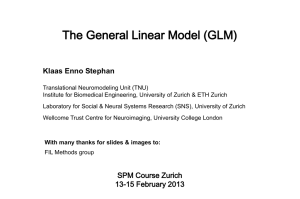
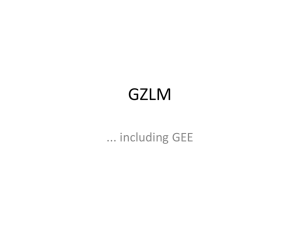
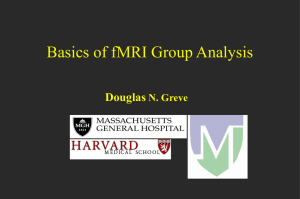

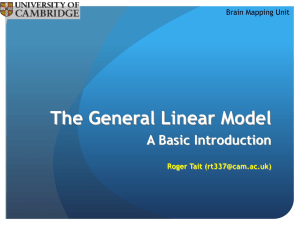

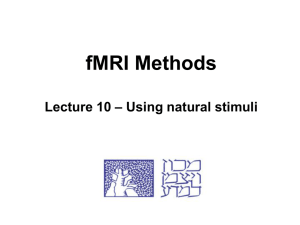
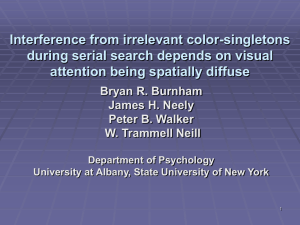
![[PowerPoint 2007] presentation file](http://s2.studylib.net/store/data/005406460_1-7834316c409f9802f7aec3d8538324fb-300x300.png)
